What We Heard Report
Rouge National Urban Park
This report was released February 1, 2022.
Download What We Heard Report (PDF, 975 KB).
Read the HTML version of the report below.
Executive summary
Over a 15-month period, from February 1, 2020, to May 1, 2021, Parks Canada led an extensive public engagement program seeking feedback on the proposed concept for the Rouge Beach Improvements Project (RBIP) in Rouge National Urban Park. This public engagement program built on several years of public consultation (2014-2019) that informed the release of the 2019 Rouge National Urban Park Management Plan, where Parks Canada committed to providing a contiguous and in-park trail connection from Lake Ontario to the Mast Trail.
Parks Canada has proposed the RBIP to enhance and further protect the natural and cultural integrity of the Rouge Beach area and foster meaningful connections to its beauty and rich history, via the following objectives:
- Mitigate the impacts of climate change, flooding and erosion;
- Improve safety, inclusivity, stewardship and connectivity for all visitors and residents;
- Restore ecosystems and improve ecological integrity;
- Respect the rights of neighbouring residential communities.
The feedback received during the public engagement period demonstrates that project elements are generally understood and largely supported. Rouge National Urban Park users are a mix of enthusiastic, curious and concerned about the developments and modifications to the park's beach and marsh area. While generally supportive of the project objectives, some members of the public expressed concerns about how the project could impact the local community and park ecology, including constructive feedback on the sustainable enjoyment of the park, privacy, visitation demands and parking. On the whole, people appreciated plans to balance ecological protection with visitor management, experience and enjoyment, and there is strong support to see the area better protected, restored, designed and managed, and for Parks Canada to improve accessibility for people of all physical abilities.
The Rouge Beach and Marsh are recognized and valued for their natural beauty and wildlife. Accordingly, the expectations for the project are that there be an appropriate focus on ecological protection. There is a desire to maintain the tranquility in balance with numerous popular visitor activities in the area, which include swimming, paddling, fishing and cycling along the Waterfront Trail and gathering with friends and family. Widespread support was expressed for improving public access for all visitors, with a diversity of ideas regarding visitor management and experiences. Many people expressed the importance of compromise in order for the area, and the entire park, to be accessible to the public and to ensure sustainable and responsible management and use. Moreover, it was noted that access to and within the area requires careful consideration and attention to detail to ensure that it meets visitor needs, links with adjacent communities, and is respectful of nearby residential communities and property owners.
Parking, the promotion of public transit and visitor use management – including working closely with the cities of Toronto and Pickering to address issues outside of Parks Canada's jurisdiction, including street parking and congestion – were also often cited as areas where Parks Canada would need to pay particularly close attention and where more attention and effort are needed.
Strong support was expressed for Parks Canada's proposed washroom upgrades, accessibility outcomes, parking enhancements, ecological restoration (including decommissioning the most damaging of the area's informal trails and the lower parking lot, which is situated in a flood plain), and erosion and flooding mitigations.
The public was presented with three options for a formalized trail connection with handrail and boardwalk components from Lake Ontario to the Mast Trail. The middle route (Option 1), garnered the strongest public and community support given it was situated the furthest away from private residences on both the Scarborough and Pickering sides of the Rouge River, as well as for the fact that this route would make use of largely pre-existing informal/unmanaged trails, thereby minimizing the human and ecological footprint of a single formalized trail. Feedback from Indigenous partners also favoured Option 1 as the route that would provide the best opportunities for natural and cultural interpretation. Options 2 and 3 were opposed by some community residents, particularly by ravine property owners on both the Scarborough and Pickering sides of the river. As a result of the feedback received, and in light of Parks Canada's desire to select a route with the smallest human or ecological footprint and the highest visitor experience potential, Parks Canada will move ahead with Option 1, subject to public feedback and considerations from the Detailed Impact Assessment.
The public's passion, commitment and connection to Rouge National Urban Park is evident in the large and inspiring levels of participation in the engagement phase of the Rouge Beach Improvements Project. Parks Canada sincerely thanks all those who took the time to comment and share their opinions, ideas, suggestions, recommendations and concerns about the proposed improvements to the area.
Background
From February 1, 2020 to May 1, 2021, Parks Canada Agency (hereafter referred to as ‘Parks Canada') conducted an extensive public engagement program on the Rouge Beach Improvements Project. This report summarizes the results of the public engagement efforts in terms of feedback received over that 15-month period.
The concept of the Rouge Beach Improvements Project was initially introduced to the public in 2012 when the initiative to create Rouge National Urban Park was launched, as well as at public meetings on the park's draft management plan throughout the fall of 2014, as well as during stakeholder consultations on the draft plan in the fall of 2016. The concept was also included in the final version of the Rouge National Urban Park Management Plan released in 2019 – which encompasses feedback from over 20,000 Canadians and more than 200 organizations – under the "Actions" section of "Management Area Concept 1 — The Heart of Park Biodiversity (south of Steeles Avenue)", recommending to:
- Connect the trail network between Rouge Beach and the north end of the management area in an environmentally sensitive manner, including:
- a boardwalk and trail between Rouge Beach and Glen Rouge Campground;
The Rouge Beach Improvements Project intends to provide necessary infrastructure and restoration of the Rouge Beach and Marsh areas. This initiative is designed to improve the ecological and cultural integrity of Rouge Beach while creating meaningful opportunities for park visitors to connect with the area's natural beauty and rich history.
The initiative's key objectives are to:
- mitigate the impacts of climate change, flooding and erosion;
- improve safety, inclusivity, stewardship and connectivity for all visitors and residents;
- restore ecosystems and improve ecological integrity; and
- respect the rights of neighbouring residential communities.
The Rouge Beach Improvements Project features a revitalization of the Rouge Beach Day Use Area, one of the most visited areas in Rouge National Urban Park; a new formalized trail connection that will provide an in-park connection from Rouge Beach to the existing Mast Trail; and a revitalization of the existing Mast Trailhead, which will be the northern limit of this new trail.
The project consists of two phases:
-
Phase 1 focuses on emergency repairs to existing beach facilities and mitigating impacts of flooding and erosion. It also includes decommissioning the lower parking (located in a flood plain); rebuilding the beach washroom; flood-proofing the access road and making it more accessible for people of all abilities by reducing the steepness of the grade and making the road into a pedestrian plaza; adding an accessible canoe and kayak launch area; as well as redesigning the upper parking lot.
-
Phase 2 centres on the construction and formalization of a trail up to 2.3 kilometres in length with handrail and boardwalk components, which will connect the beach area to the park's campground.
A dedicated public engagement phase began in February 2020 and focused on conceptual designs, with multiple community meetings and in-person walks in the Rouge Beach and Marsh areas of the park. From March 2020, constraints due to COVID-19 necessitated a shift to virtual engagement, with emails, phone calls and dozens of on-demand virtual meetings becoming the primary means of facilitating feedback.
In fall 2020, due to the volume of feedback on the project and the limitations to traditional in-person engagement as a result of COVID-19, Parks Canada extended the public engagement and commenting period for the project for a further six months to facilitate additional community input and co-design. During the extended public engagement phase, PROCESS, a Toronto-based engagement consultant team, coordinated a series of outreach and engagement activities to facilitate stakeholder and public collaboration in planning, designing and experiencing the beach and marsh spaces. In addition, Parks Canada committed to completing a Detailed Impact Assessment (DIA) – the highest standard of federal environmental impact assessment available to Parks Canada.
Public engagement process
Public engagement is integral to the process of moving forward with the Rouge Beach Improvements Project in alignment with Parks Canada policies and procedures and Rouge National Urban Park's foundational 2019 Rouge National Urban Park Management Plan and legislation, the Rouge National Urban Park Act.
Public engagement was guided by the following objectives:
- Strengthen existing and build new relationships with local communities, stakeholders and partners.
- Provide the public with opportunities to provide meaningful input on project elements.
- Ensure the perspectives of all communities of interest are heard and considered.
- Increase awareness of Rouge National Urban Park and Parks Canada.
- Clearly communicate project objectives, process and schedule.
- Develop outreach strategies that reach diverse stakeholders through the use of techniques appropriate to different groups.
- Engage a diversity of stakeholders, ranging from regular park users to park non-users and members of the general public.
- In addition to highly engaged local residents and regular park visitors, engage stakeholders who are typically not involved in consultation processes - including youth, newcomers and people with diverse abilities.
- Develop a user-centric approach to co-designing elements that are open for influence and to understand community priorities and needs in the area.
- Ensure that all who want to participate can do so.
- Ensure transparency on what is open for influence.
The desired outcomes of the engagement phase were as follows:
- Diverse participants are engaged and share their experiences and ideas for the future of the Rouge Beach Improvements Project.
- Participants learn about the Rouge Beach Improvements Project and how planning works in Rouge National Urban Park.
- All stakeholders, including Parks Canada, community members and stakeholders, feel that the process is transparent and authentic and that their concerns are heard and responded to in the design outcomes.
- Parks Canada better understands how to plan and design for a range of equitable, accessible and inclusive public experiences in a way that is responsive to varying needs, preferences and priorities.
Parks Canada identified the fundamental elements of the project with input from various stakeholders, including:
- City of Pickering
- City of Toronto
- Friends of Rouge National Urban Park
- Friends of the Rouge Watershed
- the Honourable David Crombie
- the Honourable Pauline Browes
- Oak Ridges Trail Association
- Ontario Ministry of Natural Resources and Forestry
- Pickering Accessibility Advisory Committee
- Rouge National Urban Park First Nations Advisory Circle
- Toronto and Region Conservation Authority
- University of Toronto Scarborough
- Waterfront Regeneration Trust
- West Rouge Community Association
- Ravine Property Owners' Association (West Rouge)
- Wildlands League (Toronto Chapter of the Canadian Parks and Wilderness Society)
Consultation with these and many other organizations, community groups and partners on this important project ensured that a diversity of perspectives were heard in the development and assessment of a project plan and design that addressed a multitude of interests and expertise.
Who We Heard
In addition to members of the public and local residents, Parks Canada project staff engaged with the following groups, individuals and partners:
- Aquatic Habitat Toronto
- Canadian Environmental Law Association
- Centennial Community & Recreational Association
- City of Pickering
- City of Toronto
- Clean Up Rouge Beach
- Friends of Rouge National Urban Park
- Friends of the Rouge Watershed
- Gary Anandasangaree, Member of Parliament (Scarborough—Rouge Park)
- Jennifer McKelvie, City of Toronto Councillor (Ward 25, Scarborough—Rouge Park)
- Kids in the Woods Initiative
- Oak Ridges Trail Association
- Ontario Nature
- Ontario Trumpeter Swan Restoration
- Pickering Accessibility Advisory Committee
- Pickering Field Naturalists
- Pickering Rouge Canoe Club
- Ravine Property Owners Association (West Rouge)
- Rick Hansen Foundation
- Rouge National Urban Park First Nations Advisory Circle
- Save the Rouge Valley System
- Scarborough Community Renewal Organization
- SoRo Good Neighbours
- Toronto District School Board
- Toronto and Region Conservation Authority
- Toronto Wildlife Centre
- Toronto Zoo
- TransCanada Trail
- University of Toronto Scarborough
- Waterfront Regeneration Trust
- West Rouge Community Association
- Wildlands League (Canadian Parks and Wilderness Society)
Throughout the 15-month engagement period, Parks Canada held dozens of meetings, walks, phone calls, workshops and videoconferences, leading to nearly 300 interactions with hundreds of individuals and small groups. In addition to this, more than 200 people participated in three virtual community workshops held in April and May 2021.
How We Heard
From February 1, 2020 to May 1, 2021, Parks Canada used a variety of tools and techniques to engage diverse audiences. To inform the public about the project, solicit feedback and address concerns, Parks Canada's public engagement efforts included community walks; on-demand virtual meetings, community presentations, and physically-distanced one-on-one meetings; phone calls; written responses and information sharing; and web and social media messaging. Parks Canada staff contributed articles to community association publications, including several articles in multiple issues of the West Rouge Life magazine (delivered to over 2,000 residences in the West Rouge community). Parks Canada websites featured extensive information – including a comprehensive Frequently Asked Question (FAQ) section with dozens of questions and answers – on the proposed Rouge Beach Improvements Project, and encouraged the public to email or call Parks Canada in order to comment on or request a meeting with a member of the project team. Additionally, social media channels (Twitter, Facebook), print and digital communications (postcards, park update newsletters), signage, text message alerts and virtual workshops (Zoom and Google Meets) were used to communicate project and engagement details and source public comment. Parks Canada also conducted several media interviews to highlight and raise awareness of the project, including with the Scarborough Mirror, Toronto Star, Pickering News Advertiser, TVO, Toronto.com, National Parks Traveler and the Bluffs Monitor.
Initial Public Engagement
Community Walks
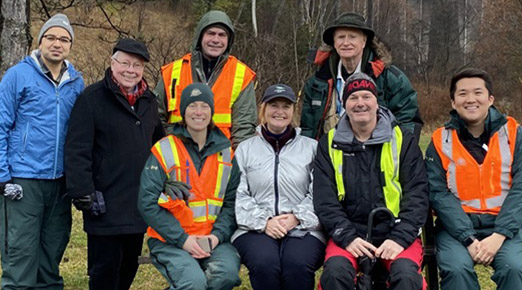
In mid-February 2020, Parks Canada hosted local community members on tours of Rouge Beach and the proposed trail options. Over 50 people – mostly locals from the immediate surrounding areas – participated in the community tours, organised by the West Rouge Community Association and the Waterfront Regeneration Trust, and the discussion and feedback received helped to inform further conversations and decisions around the future of this much loved and important area.
Let's Talk Rouge Website (www.letstalkrougenup.ca)
This dedicated online platform generated:
- more than 4,000 site visits;
- over 20 entries, suggestions and ideas for the project.
From July 2020 to January 2021, the public was invited to visit the Let's Talk Rouge website to review the project's objectives and components and to share ideas. People submitted ideas on beach and marsh activities, voiced preferences among three trail route options and identified important issues in the day use area – from ecological preservation and restoration to visitor safety and security. Contributions from the public in the website's Ideas, Survey, Stories and Q&A sections were collected and have informed project design and construction planning.
Due to public and community feedback suggesting information was difficult to find and that the Let's Talk Rouge external website was not as user-friendly as it could be, the Let's Talk Rouge website was supplanted by a new and much more detailed and user-friendly project section on Park's Canada's Rouge National Urban Park website in January 2021. This updated project section included a detailed project overview, conceptual renderings, a blog, a community partners section, and a detailed Frequently Asked Question section that answered dozens of questions posed by the public relating to the concept, parking, environmental impact assessment process, and much more. Both the Parks Canada and Let's Talk Rouge web pages remain accessible for viewing, but the Let's Talk web pages have been archived and are no longer updated. Visitors to the Let's Talk web pages can follow a link that redirects to Parks Canada's main project page.
Extended Public Engagement
In light of COVID-19 and the level of interest from the public, in the fall of 2020 Parks Canada extended the deadline for public feedback on the Rouge Beach Improvements Project by six months to May 1, 2021. As part of the extended engagement period, Parks Canada conducted community co-design workshops facilitated by a public engagement consultant (PROCESS) along with several other enriched engagement efforts.
One-to-One Meetings with Residents and Community Groups
From November 2020 to May 1, 2021, the Parks Canada project team, including the park superintendent, project coordinators and biologists, held dozens of small meetings with individual households, groups of neighbours and a number of community groups. Mostly held via videoconference in light of the pandemic, these meetings were designed to provide a comfortable and intimate format for members of the public to ask questions and clarify information with the Parks Canada project team and to provide important input regarding project concerns, gaps, interests and outcomes.
New Community Engagement Website
In January 2021, Parks Canada's projects team developed and launched new project web pages to enhance and facilitate engagement with a greater number of stakeholders. The Rouge National Urban Park website and social media channels became the main sources of Rouge Beach Improvements Project information, updates and feedback opportunities. The decision to transition from the Let's Talk Rouge website to the Rouge National Urban Park website was based on the high level of public interest, volume and content of feedback and a desire to improve accessibility to project plans and engagement details. A significant amount of public commentary and feedback about the project identified the Let's Talk Rouge website as challenging to access and navigate; therefore, Parks Canada revised its web-based engagement approach for the proposed project.
Engagement Consultant
In an effort to ensure the broadest plurality of perspectives were considered, and in response to community desire for facilitated workshops, Parks Canada brought on a consultant to help facilitate outreach during the extended public engagement phase. PROCESS, a Toronto-based engagement consultant team, employed a series of outreach and engagement activities to facilitate stakeholder and public collaboration in planning, designing and experiencing the beach and marsh spaces.
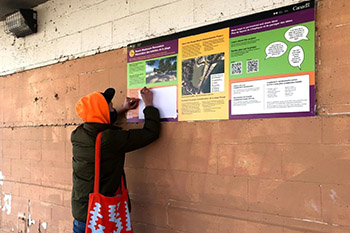
The engagement consultant produced stakeholder maps, identifying a wide range of community members, organizations, businesses and other groups to be engaged. The consultant canvassed and posted 100 posters that promoted the project – and shared details and opportunities to get involved in consultations – in community gathering places and transit stops in Scarborough and Pickering. In addition, the consultant established mobile phone text lines to provide broad audiences a simple English and French option for staying connected with the project. The consultant also installed project signage and engagement boards in and around Rouge Beach for passers-by to learn about the project and leave comments or ideas. PROCESS also mailed 1,000 postcards to residents that reside in proximity to Rouge Beach, specifically focusing on residents whose demographics had been underrepresented in earlier engagement efforts. The postcards explained project details and opportunities to get involved.
Virtual Community Workshops
PROCESS, supported by Parks Canada staff, hosted three virtual community workshops on Zoom in April and May 2021, with over 200 people participating in each of the 2-hour-long sessions. During these online workshops, Parks Canada and PROCESS presented details about the park and project, and PROCESS facilitated discussions in small breakout discussion rooms. These breakout groups were an opportunity for participants to share questions, feedback and ideas on their experience at Rouge National Urban Park and project elements using a collaborative virtual activity.
Media Relations and Targeted Communications
In the final months of the engagement period, Parks Canada initiated a significant final engagement push to ensure the highest level of public and community awareness of the project. To this end, Parks Canada staff contributed articles to community association publications, including several articles in the West Rouge Life magazine (delivered to over 2,000 residences in the Scarborough community). Parks Canada also conducted several media interviews to highlight and raise awareness for the project, including with the Scarborough Mirror, Toronto Star, Pickering News Advertiser, TVO, Toronto.com, National Parks Traveler, and the Bluffs Monitor.
Indigenous Engagement
In addition to public engagement, Parks Canada undertook a multi-year parallel engagement process with Indigenous partners through the Rouge National Urban Park First Nations Advisory Circle.
Parks Canada works with more than 300 Indigenous communities across Canada to conserve, restore and present national protected areas, while recognizing the role of Indigenous Peoples in Canada and the traditional uses of these areas. In Rouge National Urban Park, Parks Canada works with representatives from 10 First Nations through the Rouge National Urban Park First Nations Advisory Circle (FNAC">). These Nations have an expressed interest and a historic and cultural connection to the area of the national urban park. The FNAC"> consists of:
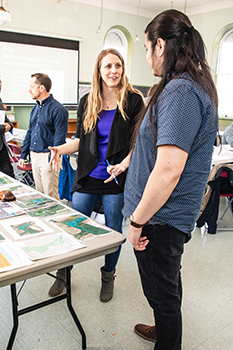
- Huron-Wendat Nation
- Mississaugas of the Credit First Nation
- The Seven Williams Treaties First Nations:
- Alderville First Nation
- Beausoleil First Nation
- Chippewas of Georgina Island First Nation
- Chippewas of Rama First Nation
- Curve Lake First Nation
- Hiawatha First Nation
- Mississaugas of Scugog Island First Nation
- Six Nations of the Grand River
The park engages with FNAC"> members throughout the year via Advisory Circle meetings, weekly phone calls, virtual and in-person workshops, site visits, co-designing of park programs and facilities, learning opportunities, field work, community visits and cross-cultural learning opportunities. Circle members also participate in a range of park programming including archaeological field work, ecological restoration and in-park visitor learning opportunities.
Parks Canada has engaged with the FNAC"> on the project concept over many years, with conversations beginning as part of the multi-year (2014-2019) engagement on the Rouge National Urban Park Management Plan. In 2020 and 2021, Parks Canada formally brought the Rouge Beach Improvements Project to the FNAC"> for review and feedback at multiple Advisory Circle meetings, including: in February 2020, in its conceptual state, to introduce the specifics of planned works in the area; and in February 2021, on a more detailed level that focused on a summary of engagement and future proposed plans for the project.
What We Heard
Engagement Assessment
Many of the people who provided feedback on the project commended Parks Canada for its flexibility and responsiveness in terms of meeting members of the public individually when possible, as this helped to address community concerns and clarify the project's objectives and rationales. Parks Canada also received positive responses on the virtual community workshops; some park users actually preferred the online format to an in-person meeting, favouring the virtual breakout groups for facilitating greater discussion.
Comments from the public also indicated an appreciation for being consulted by park staff with a view to ensuring exemplary inclusion and accessibility practices consistent with the core principles of dignity, independence, integration and equal opportunity for Canadians of all abilities.
While many people thanked Parks Canada for making a concerted effort to engage deeply with the community on this project, others felt that not enough had been done to hear the concerns of the community. There were comments asking for a further extension of the engagement phase. Recommendations from the local community implored Parks Canada to continue to involve the local community and to complete and make public the Detailed Impact Assessment in an expedited fashion. Others from the local community just wanted to see the entire area left as is and asked Parks Canada to contemplate the "do nothing" option. Despite Parks Canada's expressed commitment to incorporating feedback into project elements open for public influence, some local residents expressed concerns about how willing Parks Canada would be to adapt project plans to the outcome and direction of community input.
Indigenous Engagement
Through the circle meetings, First Nations community members were able to ask questions, share their comments and provide feedback on all project elements. After presenting the project in 2020 and 2021, the feedback Parks Canada received from Rouge National Urban Park First Nations Advisory Circle members was positive and broadly supportive of the project's objectives. There was interest in future interpretation opportunities with Indigenous partners to be able to share and showcase their stories and for Parks Canada to present the cultural heritage of the area, which could be achieved through guided and Indigenous-led walks, special programming, events or through signage and non-personal media. There was also concern expressed around a range of issues and environmental concerns currently occurring in the area, including trampling, erosion, pollution, dumping and perceived threats to natural and cultural heritage, resulting in broad support expressed for the project's environmental and restoration goals.
Listening to and meeting with Indigenous partners provided Parks Canada staff a platform to understand their perspectives and to learn more about the rich cultural heritage of this area. Another area of interest expressed at the circle meetings was for Indigenous art opportunities in this area for artists in their communities.
In terms of the trail routing options proposed, Circle members did not express a strong routing preference, although some did express support for the middle route (Option 1), as this was seen as a route that provides the best opportunities for natural and cultural interpretation.
From the 2021 Advisory Circle breakout room discussions, Parks Canada received additional feedback for project considerations. These include feedback on routing to ensure that Parks Canada presents the cultural heritage of the area along the route that is chosen, Indigenous paddling opportunities or Indigenous art opportunities to further present the cultural heritage, various themes and motifs that can be presented or interpreted in this area, stories on the importance of nature and regeneration through restoration, and the importance of reconciliation.
Project Assessment
Those who participated in the engagement phase and are in favour of the project's proposed improvements expressed a variety of reasons for their support. It is clear to many that the Rouge Beach Improvements Project is a way to protect and celebrate an important regional ecosystem. People expressed their appreciation, from a mental and physical health perspective, for the opportunity to travel the trail from the beach to the campground with their immediate and extended families safely, without having to leave the park. Engagement participants also expressed the belief that park users need to accept that the park – in particular, the beach and marsh area – must be responsibly shared among a variety of people with diverse interests and needs. People championed the area's inclusivity: its accessibility for a wide array of park users, from local residents to newcomers from farther afield, and activities. Because of the ease of access for a sizeable population to the Rouge Beach Day Use Area, well-known for its many available activities year-round, people will continue to visit and enjoy the area. While the park has been an unknown destination for people outside of the local area for many years – until recently, with the pandemic sparking an interest in this and many other previously lesser-known regional greenspaces – the sense of ownership that people feel towards it can translate into sharing the park with the GTA"> and the rest of the country.
Many members of the public strongly supported the project's overall ecological restoration objectives and, in particular, Parks Canada's desire to, over time, significantly reduce the human and ecological footprint in and around the Rouge Beach and Marsh areas by removing invasive species, closing and restoring some of the 13.5 kilometres of the current unmanaged informal/social trails, and decommissioning the lower parking lot and returning it to a more natural coastal marshland state.
There was also widespread appreciation for Parks Canada's efforts, in collaboration with local municipalities, to address traffic management concerns in and around the beach and to move parking away from the lower beach area, which has been prone to multiple significant flooding events over the past five years, often leading to environmental contamination from toxins and oils seeping into the wetland.
Support for the project was broad but not universal, and Parks Canada received a range of perspectives on the project. These concerns were mainly focused on perceived environmental impacts of construction and boardwalk infrastructure; perceived risks to wildlife; traffic, parking and congestion issues; and increases in the number of people visiting the park and nearby residential communities.
Those who were not supportive of the project's objectives, and the project as a whole, cited some of the following beliefs (some of which are further considered in more detail below this section):
- Limiting infrastructure development in the area would help maintain the natural environment.
- A trail connection from the lake to the campground is not warranted; although many informal trails exist in the area, they are predominately used by locals and have a minimal ecological footprint.
- Inviting more people into the park may lead to a proliferation of garbage issues and presents a privacy concern for nearby residents.
- Inviting more people into the community presents a potential disruption to the traditional way of life of local residents – many in the community moved into this area to enjoy the peace and quiet of the valley without contemplating a public access trail.
- Leaving the area untouched will preserve it as a "hidden gem".
- Creating a trail connection from the lake to the campground will only exacerbate parking pressures in the park and the nearby residential communities.
- People from outside the nearby community can be untrustworthy and should be kept away – building trails will only help to invite unwanted people into the area.
- There is a lack of reliable scientific information on the ecological status of the Rouge River valley south of highway 401.
- Since the project warrants a Detailed Impact Assessment, it is therefore the type of project determined to have the greatest potential for adverse and complex effects in areas of federal jurisdiction related to the environment.
Key topics
While efforts were made to make engagement as broad and inclusive as possible, some of the people who engaged in the most active dialogue about the project were those who live near Rouge National Urban Park, particularly those who live directly adjacent to the Rouge River. This audience was also the most vocal in terms of voicing concerns about various aspects of the project. Similarly, Parks Canada also heard a lot from supporters of the project who already had an active interest in and knowledge of the park, including a number of environmental stewardship organizations, ecologists, planners, community members, park users, Rouge National Urban Park partners and volunteers.
The following is a summary of the key topics that Parks Canada heard during public engagement.
Accessibility
Accessibility, one of the project's main objectives, was frequently mentioned by those who provided Parks Canada with feedback. People highlighted the importance of ensuring that access to the beach and marsh area is safe and inclusive and that all visitors have the opportunity to navigate within the area. Park users recommended that universal design (designing something to be as functional as possible for as many people as possible) be at the core of each project element, in an effort for all people, regardless of age, ability or other factors, to have a positive park experience.
People commended the project for its goal of making the green space accessible to people in the GTA">, who benefit mentally and physically from visiting the area. For many, including hikers, the proposed trail with boardwalk components is crucial to completing the park's trail system and linking Lake Ontario and the Oak Ridges Moraine – a longstanding goal of community partners and a key element of the Rouge National Urban Park Management Plan.
Park users echoed Parks Canada's safety concerns regarding accessing the beach from other areas in and outside of the park, whereby visitors often have to cross and travel along roadways without the aid of signalized crossings or sidewalks. The proposed trail with boardwalk components will mean that visitors no longer need to leave the park to transit between the Mast Trail and the beach, and Parks Canada is working with the City of Toronto about resolving parking and traffic issues in order to create safe access to the entrance of the Rouge Beach Day Use Area.
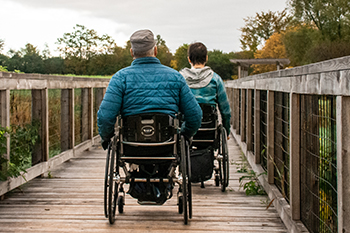
Visitors who use mobility devices, such as wheelchairs, face barriers to accessing the beach and marsh areas safely and comfortably. Park users expressed support for a trail with boardwalk and handrail components that is wheelchair accessible, allowing all visitors to see and experience more of the park. The proposed improvements, including upgrades to the beach's washroom facilities and paddling access points, will be AODA"> compliant (i.e. will meet or exceed standards from the Accessibility for Ontarians with Disabilities Act). In the engagement workshops, there were comments that were not in support of making the area accessible (e.g. with regards to the width of the boardwalk which, while it improves accessibility, increases the footprint).
The hill leading to the beach and marsh has a steep slope and is used by cars, bikes, pedestrians and more, causing conflicts in the shared space. As part of the project, Parks Canada is proposing to improve infrastructure that will enable visitors to safely access the marsh and beach from the upper parking lot. This would be achieved by reducing the grade to make it less steep and more universally accessible.
Given the distance from the upper parking lot to the beach and proposed boardwalk, there are concerns that the re-naturalization of the lower parking lot could make it more difficult for people to access the area. Many workshop participants shared that the lower parking lot broadens access to the beach and marsh to visitors with families, seniors, and diverse abilities who could not walk for a longer distance. Conversely, others expressed optimism that the entire marsh experience would in the future begin at the top of the hill and upper parking lot and, via a raised pedestrian boardwalk, users would gain a great deal of accessible space previously reserved for vehicles or inaccessible due to steep road grades.
Also, park users who commute through the area expressed hopes that access along the Waterfront Trail and on the pedestrian bridge is not negatively impacted for extended periods of time during the construction phase, although others acknowledged and understood that this likely would not be possible during certain periods of construction for visitor safety reasons.
Some locals questioned Parks Canada's intentions to make the area fully accessible for all by formalizing a single trail and ensuring its grades, surfaces and substrates are AODA"> compliant. Prevailing sentiment from some local residents was that prioritizing and maintaining local access and privacy on informal trails was of greater importance than fostering accessibility opportunities for other park visitors by making some of these informal trails accessible.
Many members of the public, including people with accessibility challenges, also provided optimism that Parks Canada could provide an accessible trail connection between the lake and the campground to improve upon the current situation where some visitors are unable to use any of the 13.5 kilometres of informal and inaccessible trails that dot the marsh and ravine area landscape. Conversely, some members of the local community, particularly those backing onto the ravine, wished for Parks Canada to leave the current informal trails alone and not apply any accessibility upgrades, noting that these trails are currently used primarily by local residents, who desire to keep it that way.
Visitation
Park users appreciate how a mix of programming in a park space fosters opportunities to gather. Workshop participants shared their excitement about park activities in the beach and marsh area, such as playing games, taking part in virtual or self-guided plant and wildlife tours, learning about Indigenous cultures and history, ice skating and meeting with friends and family to experience and enjoy the area.
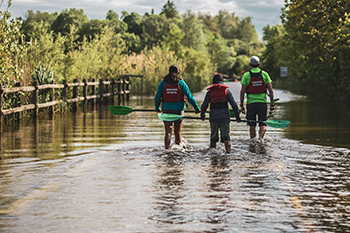
One of the biggest concerns heard was that Parks Canada will struggle to manage visitation in the Rouge Beach area in its current state, noting that when these lands transferred to Parks Canada for inclusion in Rouge National Urban Park in 2019, Parks Canada inherited an array of aging or poorly designed infrastructure. People cited a number of problematic and longstanding visitor behaviours (illegal parking, littering, partying, campfires, fireworks), poor infrastructure (washroom facilities, parking spaces, flooding issues) and visitors' conflicting activities (from passive to active). There are worries that the project's proposed improvements will lead to an increase in visitation that is unsustainable by negatively impacting: the ecology of the area (including to species at risk), the experience of park users and local residents unaccustomed to crowds, and the quality of life of the surrounding communities. Parks Canada often heard about a strong "us versus them" conflict – real and perceived – that exists between locals that "live here" and visitors that "only visit" on weekends. There is a very strong perception among many locals that the area belongs to them and that Parks Canada is responsible for facilitating and encouraging destructive levels of visitation to the area – not taking into account that the COVID-19 pandemic and local stay-at-home orders have driven increased usage of parks, greenspaces and protected areas across the country and around the world.
Conversely, many members of the public expressed a strong desire for Parks Canada to move forward with these planned improvements to specifically address such concerns by replacing aging or failing infrastructure and improving the environmental design of the area to more sustainably and responsibly manage visitor use in the area. Many feel that Parks Canada has an obligation to advance these improvements to help safeguard the area from further ecological degradation, citing issues such as the informal trails, poorly designed parking lots and lack of flooding and erosion controls as exacerbating visitor management issues. The prevailing sentiment here is that improved environmental design coupled with a reduced human footprint and ecological restoration, along with integrated and inter-jurisdictional approaches to traffic management, will all help Parks Canada to improve the situation and more sustainably manage this area of the park.
Building on this sentiment, both project supporters and those less supportive of the project agreed that in addition to any infrastructure upgrades, Parks Canada should continue and redouble its efforts to address unwanted behaviours through education, stewardship, compliance and enforcement. To this end, measures that Parks Canada has implemented to better manage the area are generally universally supported, including increased beach and community clean-up events; the creation of a local Parks Canada beach compliance team; increased Parks Canada law enforcement presence; encouraging use of public and active transit (and not cars) to access the area; discouraging visitation during peak hours; and increased collaboration with Toronto and Pickering parking enforcement units to manage and prevent illegal street parking on both sides of the river on lands outside of Parks Canada's jurisdiction.
Sharing Space
There are divergent perspectives on how space in the beach and marsh area of the park should be shared by humans, animals and plants. Park visitors frequent the beach and marsh for activities such as hiking, biking, canoeing and kayaking, birdwatching, swimming, skating and gathering with friends and family. They appreciate the multi-use functionality of the park, even if they don't participate in all the activities.
Participants discussed uses of the beach and marsh area that may conflict. For example, park users are concerned about fishing in the area, specifically litter and uncontrolled access. It was noted that fishing takes place mostly in the evenings and weekends, and this can come with an increase in garbage during these times, and disruption to other people using the area and wildlife during their most active times of day. It was also noted that fireworks are sometimes set off in the late night and early morning, which can disturb local residents.
Feedback provided to address fishing-related issues include limiting fishing to specific areas, restricting fishing from the boardwalk and bridges, and improving the accessibility of waste receptacles and the education of people who fish in the area. Although licensed fishing is a legally permitted park activity, many members of the public also perceive it to be a non-compatible and undesirable activity for a protected area like the Rouge. A very small number of people asked Parks Canada to completely ban fishing in the area.
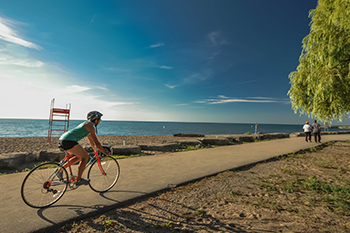
Parks Canada heard suggestions for a bike lane to be added from the upper parking lot to the proposed pedestrian plaza (or a clear demarcation of cycling/pedestrian trail lanes), as well as a separate bridge built between Scarborough and Pickering at the mouth of the Rouge River to separate user types. According to park users, these changes would improve the safety of pedestrians, people using mobility devices and cyclists.
Local residents expressed concerns about maintaining neighbourhood access to the Rouge Valley on the more than 13.5 kilometres of unofficial and unmanaged trails in the area. Although outside of the project scope, some local Scarborough residents expressed a desire for a community-only canoe and kayak launch off Island Road. Owners of ravine properties frequently cited concerns about access, safety, privacy, trespassing and property value, which were addressed in the project's Frequently Asked Questions.
Trail with Handrail and Boardwalk Components
The proposed up-to-2.4-kilometre formalized trail with handrail and boardwalk components elicited questions about its design, construction materials and methods, impact on wetland and riparian habitat and wildlife movement, as well as how it will accommodate park visitors and its accessibility objectives. In particular, the public provided divergent perspectives on whether or not formalizing a single trail would enhance park users' experiences and/or support the natural environment.
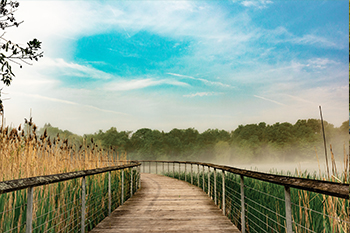
Supporters of a formalized trail with handrail and boardwalk components felt strongly that it would be an excellent way to protect and restore an ecologically sensitive area, help create a desired contiguous trail system throughout the park, restrict inappropriate activities and allow accessible connections from Rouge Beach and the local waterfront trail. Supporters of this option felt that the current use of the area is under significant ecological risk due to systemic uncontrolled access and the large human footprint that is contributing to the degradation of the area's natural environment through trampling, erosion, contamination, poaching and a range of ecological edge effects.
Some people not in favour of a formalized trail voiced strong perspectives on this, particularly people living adjacent to the ravine, commenting that a trail in the marsh would result in additional noise and disturbance to park neighbours and ravine properties; that the park and its amenities do not have capacity to support more visitors to such a trail, and that the process of formalizing the trail (both construction and maintenance impacts; and the existence of the trail itself) will harm plants and animals in the area with added litter, noise pollution and trampling of sensitive wildlife habitat.
Some comments stated with conviction that the construction and maintenance of the boardwalk would be detrimental to the environment; however, scientific evidence of this was not provided. Such considerations will be fully assessed through the Detailed Impact Assessment (DIA), which will determine impacts and mitigation/compensation measures to prevent ecological harm or provide overall benefit to the project.
During the engagement phase, the public provided feedback and ideas on what contributes to a desirable trail experience: designated areas for specific uses, such as walking, biking and off-leash dog walking, to minimize use conflicts; lookout points; and interpretive signage.
Among the people in favour of a formalized trail, public and community support was the strongest for the middle route (Option 1), which follows the footprint of the Rouge River and makes use of largely pre-existing informal trail network. Residents on the park borders were strongly opposed to the trail routes that would run closest to their properties (Options 2 and 3). Some commenters noted that Parks Canada should have included a "No Trail" option in the feasibility study (such an option will be considered in the DIA). Some park visitors who do not support a formalized trail expressed doubt regarding Parks Canada's claims that the current usage and visitor layout of the Rouge Beach and Marsh area of Rouge National Urban Park is unsustainable ecologically and that something must be done to protect this important area of the park.
Other recommendations included designing a trail wide enough to accommodate mobility devices, increasing Parks Canada's monitoring of the trails, forbidding access at night, and minimizing winter and other negative weather impacts to the boardwalk components. Some have also suggested that a formalized trail with handrail and boardwalk components should be pedestrian only, with cyclists required to walk their bicycles.
Facilities Upgrades
Park users generally feel that upgrades to facilities in the beach and marsh area are essential to increasing the overall access to and welcoming feeling of the area. The overriding public sentiment is that the washroom facilities at the beach are in dire need of upgrades or replacement. Some visitors said they avoided the washroom: it is too often locked, is unpleasant – the site of litter and vandalism – and frequently in need of maintenance. Some park users expressed a desire for both the washroom and canoe/kayak clubhouse facilities to be winterized and there is a desire for canoe/kayak storage and rental opportunities for residents and visitors.
Feedback also included a desire for additional and improved signage and wayfinding tools, which identify the distance to the washroom location and canoe/kayak launch locations. Park users also feel it is important to improve signage to include information on ecological protection. Furthermore, a number of comments expressed concerns about the distance visitors had to travel from the parking lot and other sites in the park to the washroom.
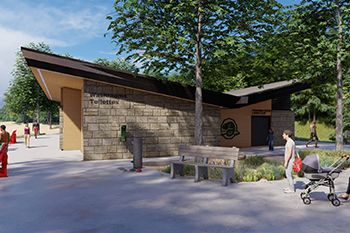
In general, participants want to see more available stalls within the beach washroom. Many want to ensure the washroom is accessible all year round and is regularly maintained. Workshop attendees indicated that they would appreciate a number of amenities in and around the washroom such as self-flushing toilets and time-limiting sinks (to limit water use), a water bottle filling station, outdoor showers, hand and foot washing stations and cell phone charging access.
A number of recommendations were made to accommodate a diversity of users, such as families and people with accessibility needs. Showers that accommodate families and people with diverse abilities, changing tables that have a hydraulic lift to accommodate adults, sinks and washroom facilities built at children's heights as well as access ramps at washroom doors.
Ecological Integrity
Many people expressed a preference for restoring park ecosystems even if that means placing constraints on how people use the park for activities, like paddling or hiking, or precluding the development of new infrastructure. Others took issue with elements of ecological restoration, including the re-naturalization of the lower parking lot and the addition of the pedestrian plaza due to their perceived restrictions on parking and access to the area.
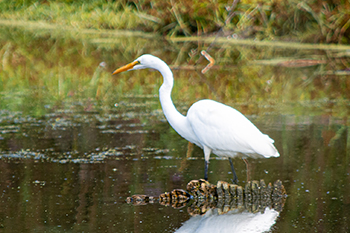
Some people expressed concern about how project construction activities could negatively impact plants and wildlife habitat and movement. Some commenters expressed a desire to know the ecological impacts and mitigations for each option. These elements are addressed in the DIA.
As indicated in the project website's Frequently Asked Questions, the project concept includes considerable ecological restoration work within the beach and surrounding marsh area, such as broad-scale invasive species management, restoration and enhancement of fish and wildlife habitat through trees and shrub planting, improving water quality, stabilization of marsh banks, shoreline grooming and garbage reduction, increased protections for species at risk, increased ecological monitoring efforts, and the addition of wildlife-proof waste management.
Flooding impacts have been factored into Parks Canada's project plans. The pedestrian plaza – formerly the lower parking lot – will be raised to accommodate potential rising of water levels, and the boardwalk height will be based on floodplain modelling to ensure the trail would clear the 100-year floodplain level. In addition, the boardwalk components would be further elevated in certain areas of the trail to facilitate the movement of wildlife and aquatic species throughout the ravine and valley. All of these elements are addressed in detail in the DIA.
Rouge National Urban Park's beach and marsh area is stewarded by neighbours and visitors, many of whom have spent many years in the area and have a connection with the land that pre-dates the park itself. Stewardship groups feel a sense of ownership of the park, and care for it as though it was their own home; Parks Canada intends to continue to foster and nurture these local organic connections to the area. Park users would like more opportunities to learn about park ecosystems and how to be stewards of the park. They seek opportunities to learn about the Indigenous history of the area and how to help protect plants and animals and keep the park free of litter.
Park users indicated that the proposed boardwalk would foster better public understanding of the land and improve the level of stewardship and respect for the park. People wrote that given the park's urban location, it is an excellent venue for outdoor educational learning, stewardship and appreciation of nature, and that Parks Canada has a responsibility to ensure young Canadians and newcomers to Canada are afforded with opportunities to learn about Canada's environment and history.
Environmental Impact Assessment
Many park users were appreciative that Parks Canada was planning to assess the project using a Detailed Impact Assessment (DIA) – the highest standard of Parks Canada environmental impact assessment in the country – and that members of the public would have additional opportunities to comment on the project once the DIA is posted on the Canadian Impact Assessment Registry. A separate and dedicated public comment period will follow during which comments about the DIA can be submitted.
There was some confusion during the engagement process over the DIA process itself (e.g. when is a DIA necessary and why does the DIA come after the project concept). To this end, Parks Canada clarified throughout the engagement period that it felt it was appropriate to undertake a DIA for this project given the sensitive environments in and around this area of the park and given the high level of public interest, to ensure there are multiple avenues for the public to provide feedback. With regards to the sequencing of the concept engagement (February 1, 2020 to May 1, 2021) followed by the release of the DIA, this is considered standard operating procedure, in that normally projects begin at the conceptual level and then move to more detailed considerations and assessment. In terms of Parks Canada's work and public engagement on this project, the project sequence will follow this pathway:
- Rouge National Urban Park Management Plan – public engagement period (2014-2019)
- Rouge National Urban Park Management Plan – released to the public (2019)
- Rouge Beach Improvements Project Feasibility Study – completed (2020)
- Rouge Beach Improvements Project – public engagement on concept (Feb 2020-May 2021)
- Rouge Beach Improvements Project – What We Heard Report (early 2022)
- Detailed Impact Assessment – released for public comment (early 2022)
Some park users requested that a "no project" option be on the table as part of the DIA (note that this option is considered and assessed as part of the forthcoming DIA). Further recommendations included the need for an environmental impact assessment that analyzes the local community's capacity to manage an increase in the volume of visitors and cars driving and parking on its streets.
For clarity, it is important to note that the Parks Canada impact assessment process has been developed to fulfil legal obligations under the federal Impact Assessment Act, as well as other legal and mandated obligations to protect and present Canada's natural and cultural heritage. Projects and activities with the greatest potential to result in adverse impacts to important natural or cultural resources are assigned to an in-depth but focused level of analysis through the impact assessment pathway. DIAs support decision-making by providing appropriate and rigorous analysis based on sound science, Indigenous knowledge and Parks Canada policy.
Transportation, Traffic and Parking
Parking management around the Rouge Beach Day Use Area is one of the biggest concerns surrounding the project. Park users, including local area residents and those accessing Rouge National Urban Park by vehicle, want to ensure there is sufficient parking to handle not only current levels of visitation, but also potential increased visitation in the future.
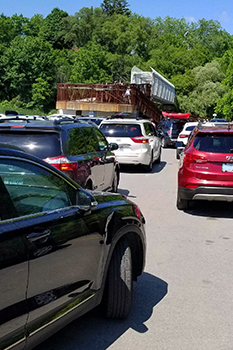
At present, the sentiment is that there is insufficient parking, particularly near the beach. The overflow of vehicles during peak times, particularly summer weekends (though this trend is evolving beyond peak summer periods) causes congestion and presents risks to residents on roads near the day use area. Local residents are concerned that increased visitation without suitable parking will continue a trend of illegal parking and risks on residential streets. To this end, the public is encouraging Parks Canada to continue to work very closely with the City of Toronto and City of Pickering, along with corresponding police and parking enforcement services, to address illegal street parking outside of Parks Canada's jurisdiction. Residents acknowledge that although these roads are outside of Parks Canada's jurisdiction, Parks Canada's compliance and law enforcement teams should continue to work closely with municipalities to ensure visitors to the Rouge Beach area avoid illegal street parking, and Parks Canada should continue to direct people away from parking in these places.
Other recommendations to alleviate parking concerns include introducing paid parking in the park, and asking Parks Canada to consider operating a shuttle bus from the Rouge Hills GO station on weekends to Rouge Beach.
Local residents and community organizations, including the West Rouge Community Association, are also asking Parks Canada to continue to work with local municipalities to consider opportunities to add supplemental parking capacity imDIAtely adjacent to the park to compliment Parks Canada's proposed redesign and expansion of the upper parking lot at the intersection of Rouge Hills Drive and Lawrence Avenue. If such plans were to move ahead, local residents expect to be engaged on and influence any such plans, including design options, the number of new parking spots, safety considerations and aesthetics.
Many locals were supportive of Parks Canada's desire to discourage and reduce visitation by vehicle to the Rouge Beach area, although some questioned how this could be achieved. To this end, residents did broadly support Parks Canada's commitment to avoid promoting the Rouge Beach area as a car-based destination and instead to strongly encourage active (walking/cycling) and public (TTC">, Durham Regional Transit (DRT) and GO Train) transportation as the primary means of visiting the beach area.
Pedestrian Plaza
Accessibility remains a concern for the lower lot and there were many comments in favour of maintaining parking exclusively for people with mobility challenges. There were also comments in opposition to the plan to decommission the lower parking level. Due to the distance between the upper parking lot and the beach, eliminating the lower lot would make the beach area inaccessible for some people. Additionally, paddlers wish to access the lower lot in order to drop off their kayak or canoe, arguing that it is time-consuming and difficult to transport watercraft from the upper lot to the water. A proposed solution identified is to ensure that there is an accessible boat launch near the upper lot to cut down on the distance to the pedestrian plaza. A second launch point would also exist where the river meets the marsh.
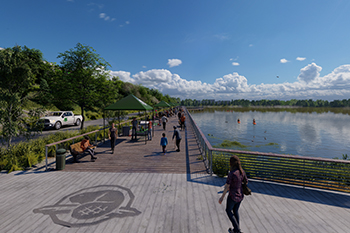
Park visitors are concerned about the marsh restoration and prefer to see a reduced footprint in the pedestrian plaza, covering less surface area than the current parking lot. People would also like to see more seating added to the plaza – covered, to protect from rain, sun and other elements – as well as consideration given to the "winterization" of new infrastructure, to better support popular winter activities such as winter hiking and ice skating.
There is no consensus on whether or not the plaza will adequately serve all park users. Instead, there were various perspective on the pedestrian plaza at multiple public workshops, with some participants expressing concerns about the plaza as well as its potential uses. The conflicting wants and needs among different types of users (cyclists, pedestrians, fishers, people with mobility devices) and overcrowding were flagged as key issues for the plaza. Despite concerns about the plaza, participants proposed many ways it could be used, suggesting numerous amenities, infrastructure and programming options, including:
- Infrastructure to minimize user conflict, such as dedicated fishing areas, bike lanes and signage or barriers to delineate space for pedestrians and other users;
- Amenities for cyclists, including lockable, visible temporary storage, a repair station and an air pump;
- Increased warden and other Parks Canada staff presence.
Workshop attendees emphasized the importance of educational and stewardship opportunities, and a strong Parks Canada visual presence in the plaza and beach areas: signage and guided tours to highlight plants and animals, Indigenous history, and the impacts of climate change, along with increased programming to encourage waterfront cleanups.
There is both support for and concerns about permitting vendors to operate in the proposed pedestrian plaza. Some workshop participants thought a small or limited number of vendors could help enhance visitor experience and safety, by providing a local and healthy food source. Opponents to this idea cautioned that it would become problematic, with the greatest concerns centred on litter and the commercialization of public space.
Finally, some members of the public requested that Parks Canada consider adding rental services for kayaks and canoes to the pedestrian plaza or along the Waterfront Trail, to provide learning and experiential opportunities for people who do not own their own equipment.
Next steps
This report summarizes the public engagement phase of the Rouge Beach Improvements Project concept. The extensive and constructive input provided by the public, Indigenous Peoples, stakeholders, partners and community groups has helped to develop, improve and enhance project plans and components.
The next stage of the Rouge Beach Improvements Project is the comment period for the Detailed Impact Assessment (DIA). The DIA will be posted on the Canadian Impact Assessment Registry and made available to anyone interested in early 2022. Following the conclusion of the commenting period, the DIA will be re-posted with a summary of the comments received and an indication of the design changes made as a result.
Afterwards, the project’s detailed design phase will begin. Engineers, landscape architects and archaeologists will complete field work and deliver a set of plans ready for implementation in the construction phase.
Subject to feedback and revisions from the DIA commenting period, the timeline for the project remains on track. Phase 1’s emergency repairs to the beach and marsh area, which will address climate change, flooding and erosion mitigation and update failing or decaying infrastructure, are anticipated to begin in spring 2022, with a targeted completion of late 2022. Phase 2 – works associated with more detailed ecological restoration and the formalizing of a trail with boardwalk components – are expected to commence in late 2022, with a targeted completion of late 2023. All dates remain targets and subject to improvements, changes and revisions stemming from public feedback received from the DIA. Parks Canada will continue to work closely with the community to provide project updates and proactively share information and plans, including potential area closures due to construction.
Parks Canada thanks the many people and organisations who invested their time, effort, thoughts and passion to help define and improve the Rouge Beach Improvements Project, and invites your continued engagement as the project proceeds.
Thank you for sharing your feedback!
The What We Heard Report is now available for the Rouge Beach Improvements Project, summarizing 15 months of public engagement.
The comment period for the Detailed Impact Assessment is now closed. All feedback received is currently being reviewed and considered by Parks Canada for inclusion in the final DIA. A report will be released soon that will summarize the public comments received, and an indication of the design changes made as a result. Once finalized, the public may request a final version of the DIA by sending an email to projetsrouge-rougeprojects@pc.gc.ca.
Parks Canada sincerely thanks all those who took the time to comment and share their opinions, ideas, and suggestions about the proposed improvements to the area.
- Date modified :